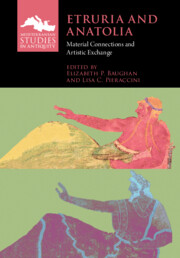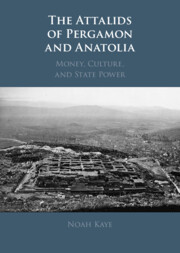Refine search
Actions for selected content:
23990 results in Ancient history
Epigraph
-
- Book:
- Etruria and Anatolia
- Published online:
- 02 March 2023
- Print publication:
- 09 March 2023, pp v-vi
-
- Chapter
- Export citation
Acknowledgments
-
- Book:
- Etruria and Anatolia
- Published online:
- 02 March 2023
- Print publication:
- 09 March 2023, pp xxi-xxii
-
- Chapter
- Export citation
13 - Chasing the Dog in Etruria and Anatolia
- from Part V - Shared and Distinct Iconographies
-
-
- Book:
- Etruria and Anatolia
- Published online:
- 02 March 2023
- Print publication:
- 09 March 2023, pp 234-249
-
- Chapter
- Export citation
Copyright page
-
- Book:
- Etruria and Anatolia
- Published online:
- 02 March 2023
- Print publication:
- 09 March 2023, pp iv-iv
-
- Chapter
- Export citation
10 - Tracing Connections between Archaic Etruria and Anatolia in Material Culture and Funerary Ideology
- from Part IV - Shared Practices
-
-
- Book:
- Etruria and Anatolia
- Published online:
- 02 March 2023
- Print publication:
- 09 March 2023, pp 182-194
-
- Chapter
- Export citation
Preface
-
- Book:
- Etruria and Anatolia
- Published online:
- 02 March 2023
- Print publication:
- 09 March 2023, pp xix-xx
-
- Chapter
- Export citation
7 - Refugee Terracotta Craftsmen from Anatolia in Southern Etruria and Latium, 550/540 to 510 BCE
- from Part III - Technology and Mobility
-
-
- Book:
- Etruria and Anatolia
- Published online:
- 02 March 2023
- Print publication:
- 09 March 2023, pp 129-142
-
- Chapter
- Export citation
Index
-
- Book:
- Etruria and Anatolia
- Published online:
- 02 March 2023
- Print publication:
- 09 March 2023, pp 333-344
-
- Chapter
- Export citation
Part II - Interpretive Frameworks
-
- Book:
- Etruria and Anatolia
- Published online:
- 02 March 2023
- Print publication:
- 09 March 2023, pp 59-110
-
- Chapter
- Export citation
9 - Luxury Consumption and Elite Lifestyles
- from Part IV - Shared Practices
-
-
- Book:
- Etruria and Anatolia
- Published online:
- 02 March 2023
- Print publication:
- 09 March 2023, pp 166-181
-
- Chapter
- Export citation
11 - Rock Tombs and Monuments in South Etruria and Anatolia
- from Part IV - Shared Practices
-
-
- Book:
- Etruria and Anatolia
- Published online:
- 02 March 2023
- Print publication:
- 09 March 2023, pp 195-214
-
- Chapter
- Export citation
Notes on Abbreviations and Spelling
-
- Book:
- Etruria and Anatolia
- Published online:
- 02 March 2023
- Print publication:
- 09 March 2023, pp xxiii-xxiv
-
- Chapter
- Export citation
6 - Wooden Furniture from Verucchio and Gordion
- from Part III - Technology and Mobility
-
-
- Book:
- Etruria and Anatolia
- Published online:
- 02 March 2023
- Print publication:
- 09 March 2023, pp 113-128
-
- Chapter
- Export citation
17 - Anatolian Fashion in Etruscan Clothing
- from Part VI - Shared Forms, Distinct Functions
-
-
- Book:
- Etruria and Anatolia
- Published online:
- 02 March 2023
- Print publication:
- 09 March 2023, pp 303-317
-
- Chapter
- Export citation
3 - Etruria and Anatolia
- from Part II - Interpretive Frameworks
-
-
- Book:
- Etruria and Anatolia
- Published online:
- 02 March 2023
- Print publication:
- 09 March 2023, pp 75-86
-
- Chapter
- Export citation

Etruria and Anatolia
- Material Connections and Artistic Exchange
-
- Published online:
- 02 March 2023
- Print publication:
- 09 March 2023

The Attalids of Pergamon and Anatolia
- Money, Culture, and State Power
-
- Published online:
- 02 March 2023
- Print publication:
- 23 February 2023
-
- Book
-
- You have access
- Open access
- Export citation
Copyright page
-
- Book:
- The Attalids of Pergamon and Anatolia
- Published online:
- 02 March 2023
- Print publication:
- 23 February 2023, pp iv-iv
-
- Chapter
-
- You have access
- Open access
- HTML
- Export citation
Dedication
-
- Book:
- The Attalids of Pergamon and Anatolia
- Published online:
- 02 March 2023
- Print publication:
- 23 February 2023, pp v-vi
-
- Chapter
-
- You have access
- Open access
- HTML
- Export citation
6 - Pergamene Panhellenism
-
- Book:
- The Attalids of Pergamon and Anatolia
- Published online:
- 02 March 2023
- Print publication:
- 23 February 2023, pp 283-353
-
- Chapter
-
- You have access
- Open access
- HTML
- Export citation
